Observing that the development of acupuncture and moxibustion is experiencing "de-China", where is the acupuncture and moxibustion of traditional Chinese medicine going?
Acupuncture has become a business card for China culture to go global.
With the gradual spread to the west, the popularity of acupuncture therapy in some developed countries even surpassed that of China. It is worth noting that in recent years, with the rise of "western medical acupuncture", the development of acupuncture in the world is experiencing "de-China".
Chinese acupuncture, where to go?
one
Acupuncture, hot!
In the early 1970s, there was an "acupuncture fever" in America.
In the summer of 1971, James Reston, then vice president of The New York Times, visited China at the invitation of the China government. During this period, due to sudden acute appendicitis, Reston was admitted to Peking Union Medical College Hospital and underwent appendectomy. On the second day after operation, Reston developed abdominal pain, and Dr. China treated him with acupuncture.
According to Reston’s memory, at that time, a young China acupuncturist put three needles under his right elbow and knees, and burned his abdomen with a kind of "cheap cigar-like" moxa roll, which obviously reduced abdominal distension.
On July 26th, The New York Times published Reston’s article "Now, About My Operation in Peking" on the front page, which described this experience and the magical effect of acupuncture.
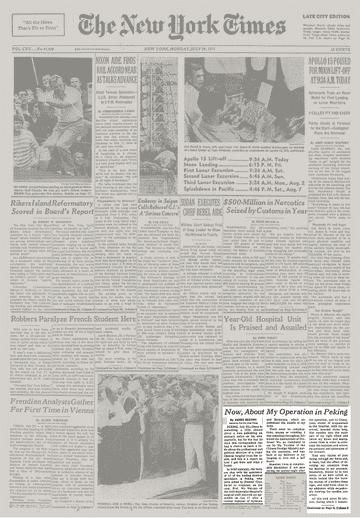
Source: new york Times Archives.
Chinese acupuncture and moxibustion is based on the holistic view of "harmony between man and nature", guided by the theory of meridians and acupoints, and uses needles and mugwort leaves as the main tools and materials to adjust the balance of human body by puncturing or fumigating specific parts of the body, thus achieving the purpose of health care and treatment.
At this time, acupuncture in China has just ushered in a leap-Chinese medical workers and scientific workers have successfully created acupuncture anesthesia. This is a model of the combination of Chinese and Western medicine, which has aroused great concern of western society about acupuncture and moxibustion in China. During their visit to China, Reston and his wife also visited China’s acupuncture anesthesia.
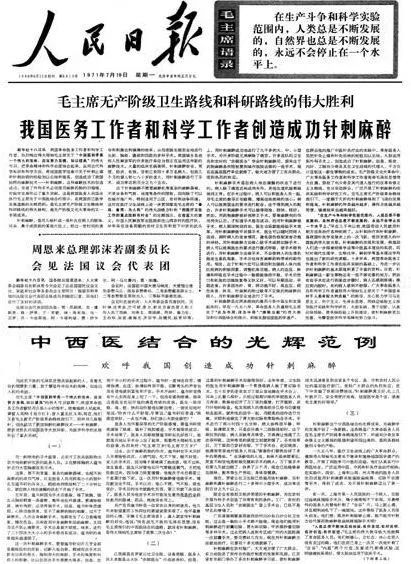
On the front page of People’s Daily, the article "Brilliant example of integrated traditional Chinese and western medicine-hail the successful creation of acupuncture anesthesia in China" was published. Source: official website, state administration of traditional chinese medicine
In the spring of 1972, US President Nixon’s delegation to China arrived in Beijing, specifically to observe acupuncture anesthesia. As a result, more than 30 members of the delegation and journalists watched the whole process of lung resection under acupuncture anesthesia in the Third Hospital of Beijing Medical University, and it was reported that there was an "acupuncture fever" in the United States.
In April, at Wes Hospital in Chicago, American doctors performed tonsillectomy under acupuncture anesthesia for the first time.
Since then, with the surge of public demand, the American acupuncture industry came into being, and acupuncture clinics began to appear everywhere. By 1997, 10,000 people in the United States had obtained acupuncture licenses, and about 3,000 doctors carried out acupuncture therapy.
Before and after the Gulf War, DARPA (Defense Advanced Research Projects Agency) paid great attention to acupuncture research applied in rehabilitation medicine and brain imaging, and strongly funded acupuncture research on treating Gulf War-related diseases and chronic headaches.
2
Chinese original
The origin of acupuncture can be traced back to the beginning of Chinese civilization.
Acupuncture, including acupuncture (pricking) and moxibustion (moxibustion), both originated in the Paleolithic Age, and is the oldest external therapy applied in primitive society in China.
Acupuncture was originally the "bian method", and the ancients often used bian stone to stab carbuncle and pus, and bian thorn to bleed. Since the Shang Dynasty, with the development of metallurgical technology, the metal "nine needles" have replaced Bian Shi as external treatment tools, and some of them are used for surgical diseases. According to Sun Simiao, a medical sage, the Yellow Emperor created nine needles in "Prepare for a Urgent Need". Moxibustion with wormwood appeared at the latest in the pre-Qin period, mainly using moxa cone burning moxibustion.
The period from Warring States to Qin and Han Dynasties is an important stage in the formation of acupuncture and moxibustion in traditional Chinese medicine. Bian Que, Fu Weng, Hua Tuo and other famous doctors are all good at acupuncture and moxibustion, and the earliest classic of traditional Chinese medicine, Huangdi Neijing, came out at this time, and acupuncture was discussed in great length.
In Wei, Jin, Sui and Tang Dynasties, acupuncture entered a period of rapid development. The publication of The Classic of Acupuncture and Moxibustion A and B established the position of acupuncture as an independent science. At the same time, the school-style education established by the government gradually emerged, and the Tang Tai Medical Department set acupuncture as an independent subject, which created a precedent for acupuncture school education.
In Song Dynasty, acupuncture prevailed. In the process of turning and copying acupuncture medical books, there are some problems such as missing the names of human meridians and acupoints. Therefore, the court appointed Wang Weiyi, who was working in yiguang at that time, to re-collate and collate acupuncture medical books. After three years of collating and textual research, The Illustration of Acupuncture and Moxibustion at Tongren Point was published, which established the national standard of acupoints at that time and had far-reaching influence.
At the same time, in order to enable learners and clinicians to accurately grasp the acupoints’ positioning as stipulated in the Classic of Acupuncture and Moxibustion on Tongren, the Song government also ordered Wang Weiyi to preside over the casting of a bronze model of acupuncture and moxibustion, which provided a more intuitive, vivid and accurate physical basis for the acupoints’ position of human body.
Zhou Mi, a famous litterateur in the Southern Song Dynasty, recorded the ingenuity and precision of acupuncture bronze men at that time in his classic "Wild Tales in Qidong". According to the book, the acupuncture bronze man has internal organs, and the acupoints on the bronze man are perforated. Water (in some versions, it is "mercury") is injected into them in advance, and then the acupoints are sealed with yellow wax, and then the medical workers can find a certain acupoint and acupuncture it. At that time, the bronze man was also stabbed through the clothes. If the needle was found accurately, water (or mercury) would naturally flow out after the needle was inserted.
In the Ming Dynasty, acupuncture and moxibustion were innovated and developed. There are some comprehensive acupuncture works, among which Yang Jizhou’s Acupuncture Dacheng has the greatest influence. Since its publication in Wanli, this book has been reprinted many times and spread widely. It has not only attracted the attention of academic circles in China, but also been translated into Japanese, French, German and other languages. In the Ming Dynasty, the government also set up an acupuncture department in Tai Hospital.
By the early and middle period of Qing Dynasty, acupuncture showed a trend of "returning from the doctor’s post to the doctor’s post", and it developed in a simple and safe direction. After long-term historical test and accumulation, both theoretical exposition and clinical diagnosis and treatment methods have matured.
Development and achievement of ancient acupuncture in China
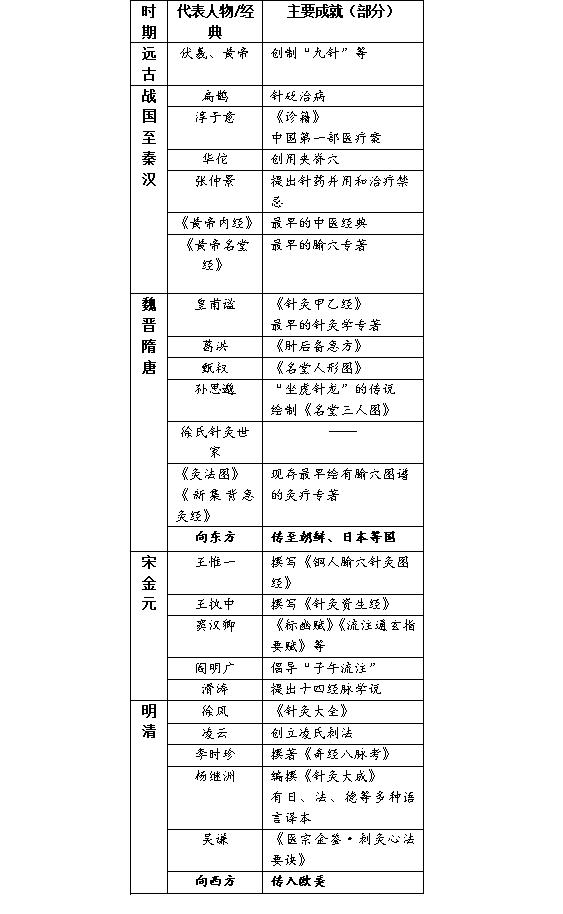
Compiled by the editor from Acupuncture and Moxibustion of Traditional Chinese Medicine, China Traditional Chinese Medicine Press, 1st edition, January 2020.
three
winding path amidst high peaks
In ancient times, acupuncture of traditional Chinese medicine has been widely spread in Asia. At the end of Ming Dynasty and the beginning of Qing Dynasty, with the increasing number of western missionaries coming to China, acupuncture therapy was brought to Europe and other places at that time, thus becoming the earliest beginning of the spread of acupuncture to the west.
However, by the end of the Qing Dynasty, the fate of acupuncture took a turn for the worse.
In 1822, Emperor Daoguang ordered: "Acupuncture has a long history, but it is not suitable for the monarch to use acupuncture and moxibustion, and the acupuncture department of Taichi Hospital means to stop forever." As a result, the practice of setting up acupuncture department in Tai Hospital changed. Since then, acupuncture has been excluded from the official medical system.
On the other hand, the fate of traditional medicine is closely related to the soil that breeds it. After the Opium War broke out in 1840, China never recovered. The spread of western medicine to the east broke the relatively closed and independent development pattern of traditional Chinese medicine, and gradually occupied the mainstream position of China medicine. Even, there has been a "total self-denial" caused by excessive "learning from foreigners"-in the century of national humiliation, we gradually lost our confidence in the quintessence of the country.
In the Republic of China, some people even put forward a motion to abolish Chinese medicine, which made the survival of Chinese medicine acupuncture face challenges. Of course, those who have a long-term plan still hold their ground. A group of people of insight, represented by Cheng Dan ‘an, have achieved certain results in the preservation and development of acupuncture through the establishment of acupuncture societies, the issuance of acupuncture publications and the development of correspondence education. In the process of active innovation, acupuncture of traditional Chinese medicine is pregnant with new life.
After 1949, acupuncture ushered in a good opportunity, and the government strongly supported the development of Chinese medicine. In 1951, the Experimental Institute of Acupuncture and Moxibustion Therapy of the Ministry of Health (the predecessor of the Institute of Acupuncture and Moxibustion of the Chinese Academy of Traditional Chinese Medicine) was established to carry out clinical and scientific research on acupuncture, with Zhu Lian as the first director. Since then, local research institutions have been established one after another, and the scientific research of acupuncture has developed rapidly. In the same year, Zhu Lian’s New Acupuncture was published and translated into many languages.
Since the 1970s, remarkable achievements have been made in the research on the mechanism of acupuncture, especially in acupuncture analgesia, acupuncture anesthesia, and the adjustment of acupuncture on visceral function, which is one of the few disciplines in which China is currently in the leading position in the world.
In April, 1975, entrusted by the World Health Organization and approved by the State Council, the China government started international acupuncture classes in Beijing, Shanghai and Nanjing successively, and trained acupuncture talents for all countries in the world.
On November 22nd, 1987, the World Federation of Acupuncture Societies was established in Beijing. It is the first international academic organization headquartered in China in history, marking the international recognition of the advanced level and leading position of acupuncture in China.
four
Western learning China.
The upsurge of acupuncture in the United States has driven more western countries to use acupuncture.
In 1970s, acupuncture got unprecedented development in Germany, and more than 30 acupuncture societies were established successively. Some scientific research institutions also gave support to acupuncture research, and more and more Germans were willing to accept acupuncture treatment.
In 1985, the French Ministry of Health set up a special committee on acupuncture, and some public hospitals often use acupuncture as a treatment, so patients can get medical insurance for it.
Since 1990, Italy has allowed clinics of local health bureaus and public medical systems or private medical institutions that have agreements with local health bureaus to provide acupuncture services. In addition, the military medical system has gradually accepted Chinese medicine, for example, the Roman military hospital officially opened the acupuncture department on December 19, 2005.
Following the establishment of "London College of Traditional Chinese Medicine" with Beijing University of Chinese Medicine in 1993, there are four universities in Britain offering undergraduate courses in acupuncture and moxibustion of traditional Chinese medicine. In 2001, he began to advocate the legislation of acupuncture and moxibustion in traditional Chinese medicine, and in 2004, he established the Chinese medicine management Committee; In 2008, the legislative group of the British Ministry of Health submitted the legislative proposal of "acupuncture, herbs and Chinese medicine" to the government. There are nearly 20 kinds of diseases treated by acupuncture, and the expenses of acupuncture treatment can be reimbursed.
In addition, acupuncture has been officially recognized by Switzerland, Austria, the Netherlands, Denmark, Belgium, Russia and other countries.
At the same time, the standardization of acupuncture and moxibustion has been paid more and more attention at home and abroad, which has further deepened the world consensus on the value of acupuncture and moxibustion.
Since 1981, the World Health Organization began to organize the work of international naming standards for acupuncture and moxibustion, and published the International Recommended Naming Standards for Acupuncture and Moxibustion in 1984.
In November 1997, the National Institutes of Health (NIH) held a hearing on acupuncture, re-evaluated the value of acupuncture and reached a consensus, and the relevant contents were published in the Journal of the American Medical Association (JAMA).
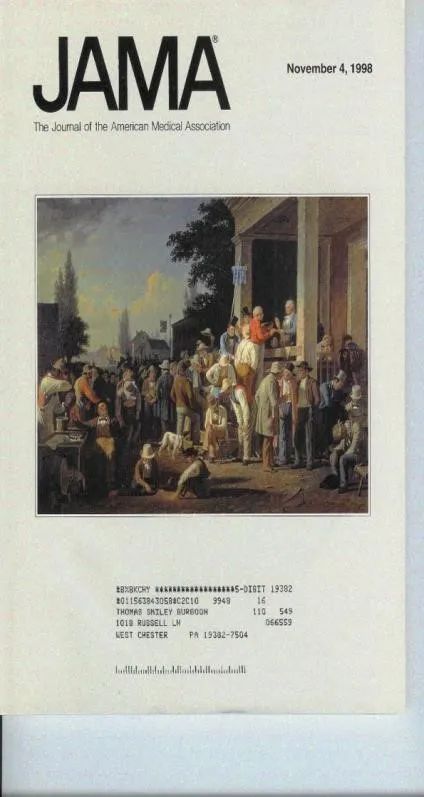
In 2006, the international standard of Acupoint Positioning of Acupuncture and Moxibustion was formulated, and the World Health Organization (WHO) established an international unified standard for the location of 361 human acupoints used in acupuncture and moxibustion in the western Pacific region.
In 2014, the International Organization for Standardization (ISO) officially published the standard of "ISO17218:2014 Disposable Sterile Acupuncture Needle", which is the first international standard issued by ISO in the field of traditional medicine in the world.
five
How powerful is it?
Acupuncture researchers at home and abroad have adopted rigorous clinical epidemiological research methods and carried out large-scale clinical verification. The current research mainly focuses on the following aspects:
* Analgesia
More than 60% of acupuncture patients in the world are pain-related diseases, and the proportion of pain patients in foreign acupuncture clinics is higher.
Acupuncture treatment of pain has obtained high-quality clinical evidence. Foreign scholars analyzed the original data of 39 randomized controlled acupuncture clinical trials in western countries from 2008 to 2015 by using single-case meta-analysis, and included 20,827 patients, which proved that the curative effect of acupuncture on head, neck, shoulder and low back pain was obviously better than that of sham acupuncture (comfort acupuncture) and no acupuncture, and the analgesic effect only decreased by 15% after one year of follow-up.
Chinese scholars have proved that acupuncture as an adjuvant therapy can definitely improve the frequency and degree of angina pectoris attacks in patients with chronic stable angina pectoris, and can alleviate the anxiety and depression symptoms of patients.
Acupuncture can also activate the human endogenous analgesic system by stimulating the body surface, so as to play an analgesic role and avoid drug resistance and addiction. In October 2018, US President Trump signed a bill called H.R.6, which aims to find alternative drugs and treatments for pain and curb the proliferation of opioid analgesic drugs in the United States. The bill will include acupuncture and medical massage. All of them are included in alternative therapies to be evaluated.
* Regulating visceral function
Acupuncture can regulate and treat visceral function, which includes specific regulation of acupoints at the same segment and non-specific and extensive regulation of acupoints at different segments. These functions are based on the participation of segmental, intersegmental and systemic (supraspinal) centers of spinal cord.
China scholars’ research in recent years shows that electroacupuncture can significantly relieve female stress urinary incontinence, and can also promote intestinal movement to treat refractory constipation. These findings were published in well-known journals with high impact factors, such as Journal of the American Medical Association (JAMA) and Annual Internal Medicine.
Acupuncture points can adjust the function of the corresponding target organs and realize the relevant transformation. For example, acupuncture at Neiguan can significantly relieve nausea and vomiting, and it has been transformed into a wearable wristband product.
Electroacupuncture can significantly improve functional dyspepsia. Experimental studies have proved that acupuncture at Zusanli can activate vagus nerve and significantly promote gastric and intestinal movements; Acupuncture at Zhongwan point inhibits gastric movement by activating sympathetic nerves at the same segment; Acupuncture at Tianshu point has a bidirectional regulating effect on intestinal movement.
* Regulation of endocrine
Acupuncture can significantly reduce the androgen level of non-obese patients with polycystic ovary syndrome (PCOS). Acupuncture combined with lifestyle intervention can improve the menstrual cycle and ovulation rate of obese PCOS patients, reduce the level of sex hormones, significantly improve the recruitment of oocytes and improve the quality of embryos.
However, some reports show that acupuncture has the same effect as fake acupuncture in improving the live birth rate of PCOS patients, which has aroused widespread concern and contention in the industry. For example, the evidence quality of acupuncture for pregnancy assistance is not high. There is no difference between acupuncture for pregnancy assistance before follicular secretion and after embryo transfer. The effect of acupuncture on relieving hot flashes of female climacteric syndrome is also unclear.
The regulating effect of acupuncture on hypothalamus-pituitary-gonad axis and hypothalamus-pituitary-adrenal axis, in addition, acupuncture activates the skin’s inherent "skin-brain axis" (HPA axis similar to the center) to exert local and systemic neuroendocrine regulation is also a hot spot in recent years.
* Regulating inflammation-immunity
The immunomodulatory effect caused by acupuncture is mainly manifested in the effect of acupuncture on immune cells, immune molecules and neuroimmunity. Cholinergic anti-inflammatory pathway is a neuroimmune pathway based on efferent vagus nerve to inhibit inflammatory response.
The research published in Nature Medicine observed the anti-inflammatory effect of electroacupuncture on mice with endotoxemia model and multi-bacterial peritonitis model, and proved that electroacupuncture at Zusanli could reduce TNF, monocyte chemoattractant protein 1, IL-6 and INF in serum of mice with endotoxemia model. Cutting sciatic nerve or vagus nerve and initial adrenal gland can block the anti-inflammatory effect of electroacupuncture. Dopamine and its receptor D1 play a role in electroacupuncture regulating inflammation.
In 2020, Chinese and American scholars jointly published the research results in Neuron, revealing that acupuncture at body surface points can induce a variety of somatic sensory-autonomic nerve-target organ reflex pathways and play a regulatory role in immunity-inflammation.
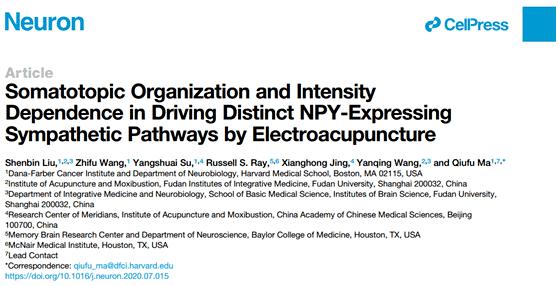
Screenshot of the page layout of Neuron magazine.
six
What are the differences between East and West?
From the above analysis, it can be seen that acupuncture is widely used in clinical treatment of diseases, and the research on acupuncture has gradually developed from traditional clinical treatment to modern experimental analysis and verification, and penetrated into modern frontier science fields. However, the purpose of clinical research in East and West is completely different.
In 1990s, in order to verify the clinical efficacy of acupuncture and provide support for health decision-making and whether acupuncture and moxibustion should be included in insurance, German federal doctors and health insurance company committees organized large-scale randomized controlled trials, RCT).
[Note: Randomized controlled trial (RCT) adopts random grouping, control and blind methods, maintains the original random grouping analysis and other measures to prevent bias, and minimizes possible bias. Therefore, RCT is considered as the gold standard for evaluating medical interventions. 】
In this experiment, "GERAC" and "ART" were set up to verify the clinical effectiveness of acupuncture in treating low back pain, knee osteoarthritis, migraine prevention and tension-type headache.
These two studies are considered to be the largest high-quality clinical trials to evaluate the effectiveness of acupuncture and moxibustion in treating pain according to modern standards, and the results were published in the famous mainstream medical journals The Lancet, JAMA, BMJ, Arch Intern Med, Ann Intern Med and BMJ. However, among the results of acupuncture randomized trials, only two proved that true acupuncture was better than false acupuncture, and six proved that false acupuncture was effective.
In China, the purpose of clinical research is often to verify or popularize that a new acupuncture treatment scheme is superior to the conventional acupuncture treatment scheme (textbook scheme), and the results are mostly positive. However, the quality of methodology is not high, especially the control of comfort acupuncture is difficult to implement. In particular, the published bias has led the international community to question the efficacy of acupuncture.
Why is there a big gap between domestic and foreign report results?
The reason is that the demand and starting point of acupuncture are different, which directly affects the research purpose and interpretation method of acupuncture RCT at home and abroad. International attention is paid to whether acupuncture is effective for a certain disease, focusing on verifying the specific efficacy caused by acupuncture. At home, RCT mainly focuses on verifying the effectiveness or superiority of acupuncture, which belongs to the comparative study of overall efficacy.
It should be noted that there are many differences between the East and the West in the study of acupuncture.
First, the theoretical basis is very different: Chinese acupuncture is guided by the basic theory of Chinese medicine and based on the theory of meridians and acupoints. However, western acupuncture does not talk about acupoints and meridians. It absorbs the research results of life science and thinks that the five major mechanisms of acupuncture are: local effect of acupuncture; The effect of acupuncture on the same spinal cord segment; The effect of acupuncture across spinal cord segments; The function of trigger point; Regulation of central nervous system.
Second, the stimulation sites are different: acupuncture in China takes acupoints as stimulation sites, and doctors need to find suitable stimulation points in acupoints by "cutting, pressing and circulating" in clinic. Western acupuncture emphasizes the stimulation point or trigger point in clinical application. The trigger point refers to the local highly sensitive tenderness point contained in the palpable tight muscle band in skeletal muscle. There is overlap between acupoints and trigger points. Although the percentage of overlap is still controversial, the overlap rate reaches 95% in the treatment of pain.
Third, the ways of stimulation are different: there are various ways of acupuncture stimulation in traditional Chinese medicine, such as filiform needle, fire needle, bloodletting, moxibustion and so on. Clinically, it pays attention to techniques and getting qi, emphasizing "qi is effective". Western acupuncture often adopts transcutaneous electrical stimulation or shallow acupuncture with weak stimulation, and the time and frequency of stimulation are also different.
Fourth, the types of diseases are different: western acupuncture and moxibustion mainly treats pain, mainly treating myofascial pain. In addition to pain, acupuncture and moxibustion in traditional Chinese medicine pays more attention to the regulation of visceral function and qi and blood of the whole body, rather than simple analgesia.
Through these comparisons, we are also more clear about the current problems faced by acupuncture in traditional Chinese medicine. Under the modern semantic framework, how to construct a modern acupuncture theory system with reasonable structure, clear hierarchy, clear concept and standardized expression, which can guide clinical practice, has become an important task at present, and can keep the foundation of the discipline.
seven
Is the surname of acupuncture in traditional Chinese medicine "Xi"?
In the process of acupuncture spreading to the world, modern acupuncture under the collision of East and West is facing the severe challenge of "internal troubles and foreign invasion".
In China, various acupuncture schools, techniques and special acupuncture methods are constantly emerging, and the traditional acupuncture theory of "internal anxiety" gradually loses its guiding role; In foreign countries, the embryonic form of "western medical acupuncture" has gradually taken shape, and the "medical acupuncture" whose "foreign invasion" is based on modern anatomy and physiology is gradually alienated or de-China, and the traditional acupuncture theory tends to be neglected.
Western acupuncture, which was born out of Chinese acupuncture, began to challenge the tradition in turn, leading to the query of Chinese acupuncture theories such as meridians and acupoints. This requires us to re-examine the functions and definitions of meridians and acupoints.
At the same time, the development of technology and technology is also changing the relationship between traditional medicine and patients. Under the influence of western science, which was born in industrial civilization and information age, the basic research and clinical research of acupuncture can be carried out in time through equipment.
In 2016, the National Institutes of Health (NIH) proposed the "SPARC Plan" to stimulate peripheral nerves to regulate the state of the body, that is, investing 238 million US dollars to develop peripheral nerve stimulation equipment. After the announcement of the plan, the funds of pharmaceutical companies and venture capital companies participating in the "SPARC Plan" exceeded 2 billion US dollars, and famous pharmaceutical companies such as GlaxoSmithKline and Internet giant Google all set up subsidiaries to carry out research and development.
Even, the popularity of acupuncture treatment in some developed countries has surpassed that of China.
According to the data of Arensbach Institute, an authoritative polling agency in Germany, more than 2 million Germans receive acupuncture treatment every year, and about 61% of Germans express their hope to treat diseases by combining traditional Chinese and western medicine. The number of patients receiving acupuncture treatment and the number of registered acupuncturists in the United States increased by 50% and 100% respectively from 2002 to 2012.
However, in the past 10 years, the clinical diagnosis and treatment rate of acupuncture in China has only increased by about 10 percentage points, and the number of acupuncture practitioners has increased by less than 5%.
eight
Regain self-confidence
Under the tide of globalization, acupuncture has become the forerunner of Chinese medicine to the world. Compared with Europe and America, the advantages of acupuncture in China are far from being brought into play. What should we do?
It is very important to develop and protect the intellectual property rights of traditional Chinese medicine.
In June, 2006, the first batch of national intangible cultural heritage list in China was published, and the acupuncture projects jointly declared by Chinese Acupuncture Society and Acupuncture Institute of Chinese Academy of Traditional Chinese Medicine were listed as one of them, which created good conditions for Chinese acupuncture to declare the representative list of human intangible cultural heritage.
In the same year, China also launched the declaration of the world intangible cultural heritage of traditional Chinese medicine-with the overall content of "traditional Chinese medicine", which was named "Cognition and Practice of Life Diseases of Traditional Chinese Medicine".
However, due to the rich traditional culture and philosophy of China contained in traditional Chinese medicine, its huge system, numerous schools and wide application of clinical techniques to prevent and treat diseases, in June 2009, the Intergovernmental Committee for the Protection of Intangible Cultural Heritage of UNESCO decided that the declared "traditional Chinese medicine" is an intangible cultural heritage project with unclear inheritance group, and its definition is unclear, which will lead to weak protection pertinence, so it is suggested to re-declare it after revision.
After discussion, experts in the cultural heritage industry and the Chinese medicine industry decided to choose a specific category that best reflects the traditional Chinese medicine culture-Chinese medicine acupuncture to declare.
Finally, it lasted nearly four years. On November 16th, 2010, at the fifth meeting of the Intergovernmental Committee for the Protection of Intangible Cultural Heritage in Nairobi, Kenya, "Acupuncture and Moxibustion of Traditional Chinese Medicine" was successfully selected into the "Representative List of Intangible Cultural Heritage of Humanity" through deliberation.
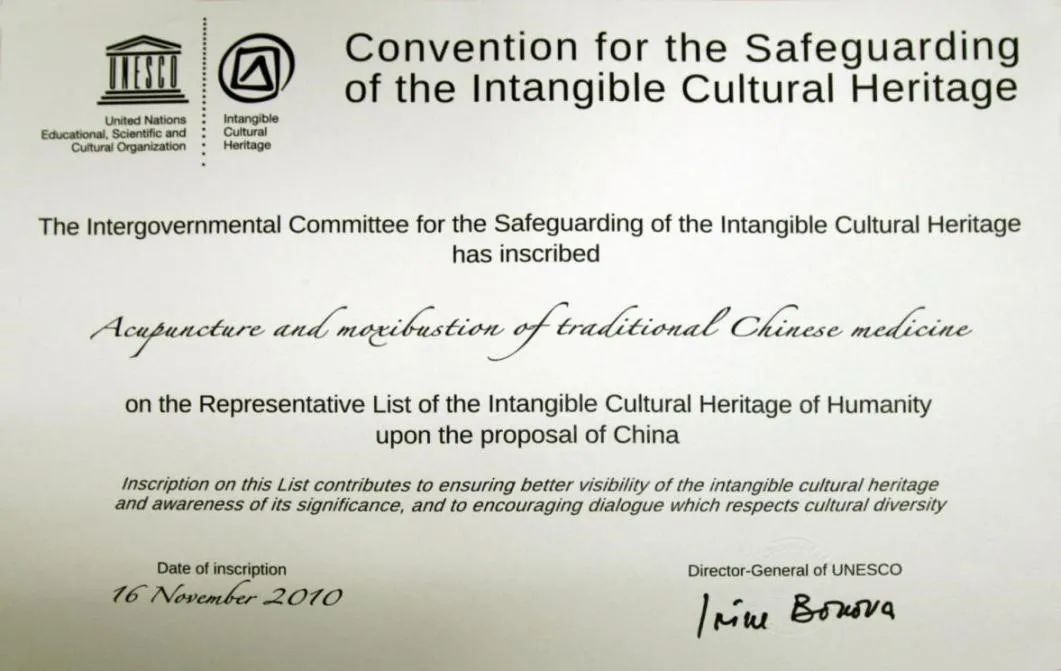
Chinese medicine acupuncture is listed in the "representative list of human intangible cultural heritage" certificate.
In 2018, UNESCO designated November 15th as "World Acupuncture Day", which indicated that acupuncture in China has become the world acupuncture.
With the accelerating internationalization of acupuncture and moxibustion, under the challenge of "internal troubles and foreign invasion", how can Chinese acupuncture and moxibustion achieve better development?
Since ancient times, acupuncture and other external treatments of traditional Chinese medicine have occupied half of the treatment of traditional Chinese medicine. Inheriting acupuncture and moxibustion of traditional Chinese medicine can not be ignored. At the same time, under the background of modern medicine, how to realize the integration of traditional acupuncture and modern research, inherit the essence of traditional Chinese medicine acupuncture and incorporate the new knowledge of modern science? This is also a breakthrough in the development of acupuncture.
The World Health Organization (WHO) pointed out in its report "Meeting the Challenges of the 21st Century": "In the 21st century, medicine should not continue to take diseases as the main research field, but should take human health as the main research direction", emphasizing that "health is the basic right of human beings" and paying attention to the individual’s "ability to discover and develop self-health".
Today’s medicine is changing from "disease medicine" to "functional medicine", which means that the barrier of disease prevention and treatment has moved forward. Acupuncture is precisely by stimulating the body surface to achieve the regulation of human functions, mobilize the self-healing ability of the human body, and prevent it from gradually becoming an organic disease, which coincides with the current health concept.
[Note: Diseases begin with dysfunction, and usually turn into organic lesions after 10 to 30 years of pathological process. 】
We believe that when acupuncture, an ancient therapeutic method, embraces modern science, it can provide more possibilities for human health. Reducing drug abuse and side effects through acupuncture of traditional Chinese medicine, a green medical method, will put forward a distinctive Chinese plan for human health.
Wen | Jing Xianghong, Director of the Institute of Acupuncture and Moxibustion, Chinese Academy of Traditional Chinese Medicine, and Chief Physician of Acupuncture and Moxibustion Hospital, Wang Yingying.
Editor | Wang Yiwen looked at the think tank
In order to reprint the original articles of Wangzhi think tank, please indicate the source of Wangzhi think tank (zhczyj) and the author’s information before the article, otherwise the legal responsibility will be strictly investigated.
Original title: "The treasures of our ancestors are being" de-China "by the West. We should be in a hurry! 》
Read the original text